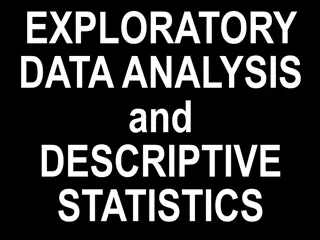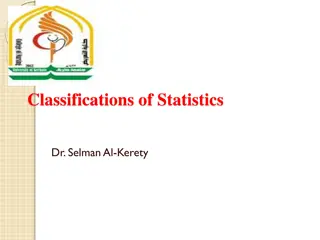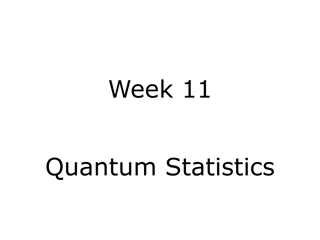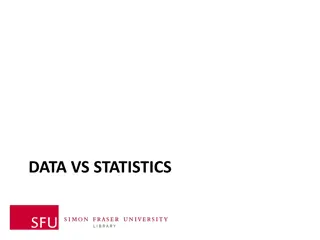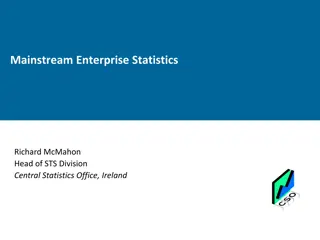
Measures of Central Tendency and Dispersion in Statistics
Explore central measures like mean, median, mode, and dispersion measures like range, standard deviation. Learn to analyze data sets, identify outliers, and apply statistical concepts. Improve your grasp of statistics with practical examples and explanations.
Download Presentation

Please find below an Image/Link to download the presentation.
The content on the website is provided AS IS for your information and personal use only. It may not be sold, licensed, or shared on other websites without obtaining consent from the author. If you encounter any issues during the download, it is possible that the publisher has removed the file from their server.
You are allowed to download the files provided on this website for personal or commercial use, subject to the condition that they are used lawfully. All files are the property of their respective owners.
The content on the website is provided AS IS for your information and personal use only. It may not be sold, licensed, or shared on other websites without obtaining consent from the author.
E N D
Presentation Transcript
This Slideshow was developed to accompany the textbook Larson Algebra 2 By Larson, R., Boswell, L., Kanold, T. D., & Stiff, L. 2011 Holt McDougal Some examples and diagrams are taken from the textbook. Slides created by Richard Wright, Andrews Academy rwright@andrews.edu
Measure of central tendency A number used to represent the center or middle of a set of data values. Mean , or average, of n numbers is the sum of the numbers divided by n. ? =?1+ ?2+ + ?? ?
Median middle number when the numbers are written in order. (If n is even, the median is the mean of the two middle numbers.) Mode number or numbers that occur most frequently. There may be one mode, no mode, or more than one mode.
The winning scores of 6 baseball games are 5, 7, 8, 5, 10, 3 Find the mean, median, and mode. Put the numbers in order 3, 5, 5, 7, 8, 10 Mean = 3+5+5+7+8+10 = 6.33 6 Median = average of two middle numbers = 5+7 2 Mode = 5 = 6
Measure of dispersion Statistic that tells you how dispersed, or spread out, data values are. Range difference between the greatest and least data values. ????? = ??? ??? Find the range of the following data sets. 14,17,18,19,20,24,30,32 32 14 = 18 8,11,12,16,18,18,18,20,23 23 8 = 15
Standard deviation describes the typical differences (or deviation) between a data s value and the mean. (?1 ?)2+(?2 ?)2+ + (?? ?)2 ? ? =
Find the mean Find the standard deviation of the following data set. 4,8,12,15,3 4+8+12+15+3 5 ? = = 8.4 Finding the standard deviation on a TI calculator [STAT] Edit, Enter data values in L1 (clear list first) [STAT] CALC 1-Var Stats, [ENTER] x2 , Find ?x 4 8.42+ 8 8.42+ 12 8.42+ 15 8.42+ 3 8.42 5 = 4.59
Outliers Value that is much greater than or much less than most of the values in a data set. Can skew measures of central tendency and dispersion
Air Hockey You are competing in an air hockey tournament. The winning scores for the first 5 games are given below. 14,15,15,17,11 a. Find the mean, median, mode, range, and standard deviation of the data set. ? = 14.4,??? = 15,???? = 15,????? = 6,? 1.96 The winning score in the next game is an outlier, 25. Find the new mean, median, mode, range, and standard deviation. ? = 16.2,??? = 15,???? = 15,????? = 14,? 4.34 Which measure of central tendency does the outlier affect the most? the least? The mean is most affected by the outlier. The mode is least affect by the outlier. d. What effect does the outlier have on the range and standard deviation? The outlier causes both the range and standard deviation to increase. b. c.
On the homework, do one standard deviation by hand. You can use your calculator to do the rest.
This Slideshow was developed to accompany the textbook Larson Algebra 2 By Larson, R., Boswell, L., Kanold, T. D., & Stiff, L. 2011 Holt McDougal Some examples and diagrams are taken from the textbook. Slides created by Richard Wright, Andrews Academy rwright@andrews.edu
Adding a Constant to Data Values When a constant is added to every value in a data set, the following are true: The mean, median, and mode of the new data set can be obtained by adding the same constant to the mean, median, and mode of the original data set. The range and standard deviation are unchanged.
The data below give the weights of 5 people. At the end of a month, each person had lost 3 pounds. Give the mean, median, mode, range, and standard deviation of the starting weights and the weights at the end of the month. 138, 142, 155, 140, 155 Mean: 146 Median: 142 Mode: 155 Range: 17 Std. Dev.: 7.46 3 = 143 3 = 139 3 = 152 ??? ????? = 152 ??? ????? = 7.46
Multiplying Data Values by a Constant When each value of a data set is multiplied by a positive constant, the new mean, median, mode, range, and standard deviation can be found by multiplying each original statistic by the same constant.
The data below give the weights of 5 people. Give the mean, median, mode, range, and standard deviation for the weights of the 5 people in kilograms. (Note: 1 pound 0.45 kilogram) 138, 142, 155, 140, 155 Find the mean, median, mode, range, SD in lbs (see previous example for these numbers) Mean: 146 Median: 142 Mode: 155 Range: 17 SD: 7.46 0.45 = 3.36 0.45 = 65.7 0.45 = 63.9 0.45 = 69.75 0.45 = 7.65
This Slideshow was developed to accompany the textbook Larson Algebra 2 By Larson, R., Boswell, L., Kanold, T. D., & Stiff, L. 2011 Holt McDougal Some examples and diagrams are taken from the textbook. Slides created by Richard Wright, Andrews Academy rwright@andrews.edu
A normal distribution is modeled by a bell-shaped curve called a normal curve that is symmetric about the mean.
A normal distribution with mean ? and standard deviation ? has the following properties: The total area under the related normal curve is 1. About 68% of the area lies within 1 standard deviation of the mean. About 95% of the area lies within 2 standard deviations of the mean. About 99.7% of the area lies within 3 standard deviations of the mean.
A normal distribution has mean and standard deviation. For a randomly selected x-value from the distribution, find P( ? ? ? ? + 3?) Add the percents between the lines marked ? ? and ? + 3? 34% + 34% + 13.5% + 2.35% 83.85%
The weight of strawberry packages is normally distributed with a mean of 16.18 oz and standard deviation of 0.34 oz. If you randomly choose 2 containers, what is the probability that both weigh less than 15.5 oz? 15.5 = 16.18 2 0.34 = ? 2? Add the percents for the areas below ? 2? ? 15.5 = 0.15% + 2.35% = 2.5% = 0.025 We want two packages, so multiply the individual probabilities ?( 15.5)?( 15.5) = 0.025(0.025) = 0.000625
The standard normal distribution is the normal distribution with mean = 0 and standard deviation = 1. Formula = ? =? ? ? The z value for a particular x-value is called the z-score for the x-value and is the number of standard deviations the x-value lies above or below the mean ?.
If a z-score is known, the probability of that value or less can be found from a Standard Normal Table. P(z -0.4) = 0.3446
Finding Probabilities with Z-scores using a TI-graphing calculator use the normalcdf function. It computes P(?1< ? < ?2), which is the area under the standard normal curve between ?1????2. To calculate P( 1 < ? < 2), press 2nd DISTR, normalcdf( and then press ENTER. After normalcdf( type -1 , 2 ) and then press ENTER. If you want ?(? < 2) do normalcdf(-100,2) If you want ?(? > 2) do normalcdf(2, 100) normalcdf(-1,2) = 0.8186
A survey of 20 colleges found that the average credit card debt for seniors was $3450. The debt was normally distributed with a standard deviation of $1175. Find the probability that the credit card debt of the seniors was at most $3600. Step 1: Find the z-score corresponding to an x-value of $3600. ? =? ? ? 3600 3450 1175 = 0.13 Step 2: Use the table or normalcdf to find P(? $3600). P(? 0.13) = 0.5508
This Slideshow was developed to accompany the textbook Larson Algebra 2 By Larson, R., Boswell, L., Kanold, T. D., & Stiff, L. 2011 Holt McDougal Some examples and diagrams are taken from the textbook. Slides created by Richard Wright, Andrews Academy rwright@andrews.edu
Population A group of people or objects that you want information about. Sample When it is too hard to work with everything, information is gathered from a subset of the population. There are 4 types of samples: Self-selected member volunteer Systematic rule is used to select members Convenience easy-to-reach members Random everyone has equal chance of being selected
A manufacturer wants to sample the parts from a production line for defects. Identify the type of sample described. The manufacturer has every 5th item on the production line tested for defects. Systematic The manufacturer has the first 50 items on the production line tested Convenience
Unbiased Sample Ensure accurate conclusions about a population from a sample. An unbiased sample is representative of the population. A sample that over- or underrepresents part of the population is a biased sample. Although there are many ways of sampling a population, a random sample is preferred because it is most likely to be representative of the population.
A magazine asked its readers to send in their responses to several questions regarding healthy eating. Tell whether the sample of responses is biased or unbiased. Explain. The sample is biased because only readers with strong opinions will respond.
The owner of a company with 300 employees wants to survey them about their preference for a regular 5-day, 8-hour workweek or a 4-day, 10-hour workweek. Describe a method for selecting a random sample of 50 employees to poll. Example answer: Placing the names in a hat and choosing 50 at random.
Sample Size When conducting a survey, the larger the sample size is, the more accurately the sample represents the population. As the sample size increases, the margin of error decreases. Margin of error Gives a limit on how much the responses of the sample would differ from the responses of the population. For a sample size n, the margin of error is: Margin of error = 1 ?
Survey In a survey of 1535 people, 48% preferred Brand A over Brand B and Brand C. What is the margin of error for the survey? Margin of error = ? 1 1535= 0.026 ?? 2.6% Give an interval that is likely to obtain the exact percent of all people who prefer Brand A. Take the average and margin of error 48% 2.6% Between 45.4% and 50.6% 1
A polling company conducts a poll for a U.S. presidential election. How many people did the company survey if the margin of error is 3%? 1 ? ?????? ?? ????? = 1 ? 0.03 = 1 ? 0.03 = 0.03 ? = 1 1 ? = 0.03 2 1 ? = N = 1111 people = 1111.11 0.03
This Slideshow was developed to accompany the textbook Larson Algebra 2 By Larson, R., Boswell, L., Kanold, T. D., & Stiff, L. 2011 Holt McDougal Some examples and diagrams are taken from the textbook. Slides created by Richard Wright, Andrews Academy rwright@andrews.edu
To find the best model for a set of data pairs (x, y) 1. Make a scatter plot 2. Determine the function suggested by the plot y=ax+b 15 Linear ? = ?? + ? 10 5 0 0 1 2 3 4 5
Quadratic y = ??2+ ?? + ? Cubic ? = ??3+ ??2+ ?? + ? y=ax2+bx+c y=ax3+bx2+cx+d 5 40 0 20 0 1 2 3 4 5 -5 0 0 1 2 3 4 5 -10 -20
Exponential ? = ??? Power ? = ??? y=abx y=axb 1.5 60 1 40 0.5 20 0 0 0 1 2 3 4 5 0 1 2 3 4 5
To graph data on TI-Graphing Calculator 1. STAT Edit 2. Clear lists by highlighting L1 (or L2) and push CLEAR 3. Enter x-values in L1 and y-values in L2 4. Push Y= clear any equations 5. In Y= hightlight Plot 1 and push ENTER 6. To zoom push ZOOM ZoomStat 7. Choose type of graph (linear, quadratic, cubic, exponential, power) This can be done on Excel if you don t have a graphing calculator.
To see your regression with your data points 1. Select the type the regression from STAT CALC 2. Specify the x-data (2nd L1) 3. Comma 4. Specify the y-data (2nd L2) 5. Comma 6. Name the regression Y1 (VARS Y-VARS Function Y1) 7. You should see yourReg L1, L2, Y1 8. Push Enter 9. Push Graph This can be done on Excel if you don t have a graphing calculator.
Microsoft Excel 1. Enter your data in two columns 2. Highlight the columns and click Insert Scatter You should now have a scatter plot 3. To get a regression a. Select your graph and click Chart Tools Layout Trendline More Trendline Options b. Select your regression type (quadratic is polynomial order 2, cubic is polynomial order 3) c. Checkmark the Display Equation on Chart box d. Click OK and your regression and equation will be on the graph




